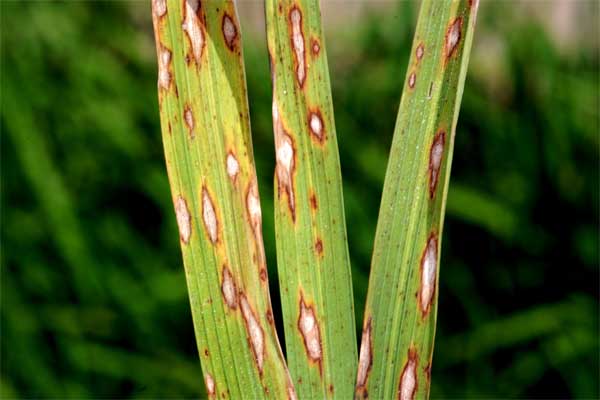
Rice Blast
Description:
It is found wherever rice is grown and it has become potential threat to food security due to pathogen’s ability to survive in harsh environments and easy spread.
Importance:
Each year it is estimated to destroy enough rice to feed more than 60 million people. The fungus is known to occur in 85 countries worldwide.
Etiology:
Causal organism: Pyricularia oryzae
Order: Moniliales
Family: Dematiaceae
Symptoms:
The fungus attacks all aboveground parts of the rice plant. Depending on the site of symptom rice blast is referred as leaf blast, collar blast, node blast and neck blast.
- Leaf blast: The lesions on leaf blade are elliptical*(resemble with oval) or spindle*(tooth pick shaped) shaped with brown borders and gray centers.
- Collar blast: It occurs when the pathogen infects the collar*(collar like band present at the base where leaf is connected to stem) that can kill the entire leaf blade*(broad portion of leaf).
- Node blast: The pathogen also infects the node of the stem that turns blackish and breaks easily.
- Neck blast: The panicle can also be infected. Infected neck is girdled by a grayish brown lesion that makes panicle fall over when infection is severe.
Disease cycle:

Epidemiology:
- Cloudy skies, frequent rain, and drizzles favor the development and severity of rice blast.
- High nitrogen levels, high relative humidity, and wet leaves encourage infection caused by the fungus.
- The rate of sporulation*(fungus spore production) is highest with increasing relative humidity of 90% or higher.
- For leaf wetness, the optimum temperature for germination of the pathogen is 25-28 °C.
Management:
- Cultural practices: Field sanitation*(to remove weeds, debris which may harbor the pathogen), destruction of alternate host*(which can be infected apart from rice).
- Nitrogenous fertilizer should be applied in minimum doses to avoid from prolonged vegetative period that is more likely to be attacked by the blast disease.
- Seed treatment with proper seed dressing fungicides such as Benlate (0.25%).
- Foliar sprays with Kasumin 2 WP, Benlate, Bavistin (0.1%).


